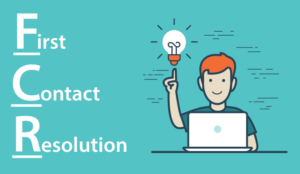Solving any problems quickly and effectively is central to achieving high customer satisfaction levels. Consumers don’t want to be forced to make contact again to resolve an issue. They don’t want to wait for an agent to call them back with an answer.
Research in the ContactBabel UK Customer Experience Decision Makers Guide 2021-22, sponsored by Enghouse Interactive, backs this up. The report surveyed consumers and customer service professionals based in the UK.
Both agree that First Contact Resolution (FCR) is key to customer service success. Across every age group, consumers ranked FCR as the most important factor when dealing with an organisation. FCR was ahead of short waiting times, long opening hours and polite employees.
50% of businesses said their customers valued getting problems solved first time as their priority.
Identifying the Benefits of High First Contact Resolution Rates
Achieving high FCR rates helps both consumers and businesses. Eliminating the need for customers to make multiple contacts to resolve their issues is a clear signal that a business values their time. Done well it can turn around negative opinions and boost customer loyalty.
For businesses, it increases efficiency by reducing contact volumes. This is particularly important at the moment, with ContactBabel’s research showing that most sectors are experiencing higher call volumes post-pandemic.
81% of customer service respondents say this has been driven by people’s greater need for confidence that their issues are resolved. So getting it right first time delivers reassurance to consumers. It also removes prevents further calls or call-backs, freeing up agent time for other queries.
Understanding the Issues When Tracking First Contact Resolution Rates
Comparing ContactBabel’s data shows that FCR rates have actually fallen over the last few years, from 78% in 2017 to around 74% in 2021.
However, it is important to look behind this headline rate, as multiple factors can have an impact on the numbers. For example:
- Moving simple, repetitive activities (such as checking where an order is or finding out basic information) to self-service will mean that remaining calls are likely to be more complex, and potentially difficult to solve in a single interaction lowering FCR
- On the other hand, if self-service is not working properly, more consumers will switch to the phone for simple queries that can be resolved on a single call. This will increase FCR rates. However, in this case, a higher FCR rate is not a positive since it shows an underlying need to re-engineer self-service.
- There could be issues with other parts of the business not taking the necessary action. This forces consumers to call back, even though the contact centre agent resolved their query and passed it onto the correct department. 23% of respondents reported that more than half of their call-backs were due to these failures in downstream processes and actions.
- Unclear communications (such as confused marketing, or incorrect billing) can cause people to call unnecessarily. While these may be simple to resolve in a single call, the resulting higher FCR numbers mask the issue that is driving people to make contact.
Effectively Improving First Contact Resolution Rates
Given its importance, organisations need to be continually looking to improve their FCR rates. This requires a focus on four key areas:
1. Adopt a Consistent Methodology for Measuring and Tracking FCR
You can measure the successful conclusion of customer interactions in multiple ways. For example, you can:
- Ask agents to mark whether a query has been satisfactorily resolved
- Track issues to see if they were re-opened
- Deploy supervisors to monitor calls and check if they are concluded (quality assurance)
- Automate the analysis of call recordings to see if the query was resolved
- Ask customers if they feel their issue has been resolved either via agents or by conducting a post-call IVR survey.
90% of contact centres use quality assurance monitoring to gather FCR data. 71% of contact centre professionals that had deployed this method score it as ‘very useful’ for measuring FCR. While 27% saw it as very/somewhat useful but not as effective as the automated analysis of call recordings.
2. Build Effective Collaboration Between Departments
Too often queries seen as dealt with by the contact centre hit a roadblock elsewhere in the business. Different departmental processes must sync up to deliver on what customer service agents tell consumers is going to happen.
For example, if an agent promises the customer that a replacement product within 24 hours, there needs to be a clear process to notify the warehouse team about this and ensure it happens. Otherwise, consumers will end up calling again, lowering FCR rates
3. Share and Update Knowledge Constantly
Making sure that all agents have access to the latest information is crucial to ensuring they can answer queries without needing to put callers on hold or phoning back.
The best way to make this happen is through a single knowledge base which can be accessed by all agents and is constantly updated with new answers. This helps drive higher FCR and improved consistency.
4. Communicate Clearly Across the Business
For example, make the customer service team is fully aware of any events that are likely to generate more calls. This could be a new product launch, or a redesigned bill that customers are unfamiliar with. Brief the the contact centre briefed about these events ahead of time so they can prepare.
Where possible, add relevant information to the website/self-service system in order to deflect basic queries.
Nearly half (49%) of B2C companies say good customer service is a top way of gaining a competitive advantage. However, in an increasingly complex world, consumers are more likely than ever to contact a brand.
How you deal with these queries and meet their needs is therefore critical. Adopting the correct strategy to increase First Contact Resolution rates within your organisation is crucial to ongoing customer service success.
This blog post has been re-published by kind permission of Enghouse Interactive – View the Original Article
For more information about Enghouse Interactive - visit the Enghouse Interactive Website
Call Centre Helper is not responsible for the content of these guest blog posts. The opinions expressed in this article are those of the author, and do not necessarily reflect those of Call Centre Helper.
Author: Enghouse Interactive
Published On: 17th Dec 2021
Read more about - Guest Blogs, Enghouse Interactive






 Enghouse Interactive delivers technology and expertise to help bring your customers closer to your business through its wide range of customer contact solutions.
Enghouse Interactive delivers technology and expertise to help bring your customers closer to your business through its wide range of customer contact solutions. 








